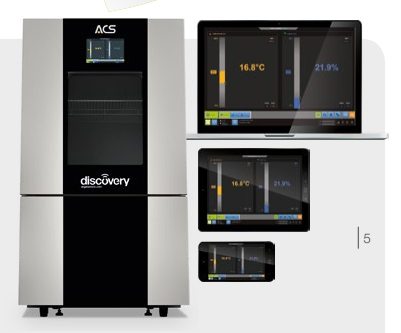Manufacturer: Angelantoni / Origin: Italia
The range of the ACS “ES” series Climatic and Thermostatic Chambers allows you to control the temperature and humidity inside the test compartment, in a range from -70°C to +180°C (temperature) and from 10% to 98% (relative humidity), with a rate of temperature change of at least 5K/min.
Specifications:
| Model: DM600 T |
| Useful capacity (l): 553 |
| Internal dimensions approx. (mm): 850x730x892 |
| External dimensions approx. (mm): 1124x1768x2049 |
| Temperature range (°C): -40…+180 -75…+180 |
| Temperature fluctuation (K): ±0.1...±0.3 |
| Temperature changing rate: Heating: Basic (-40/+180°C) 4,5K/min C model (-70/+180°C) 4,5K/min |
| Temperature changing rate Cooling: Basic (+180/-40°C): 4,5K/min C model (+180/-70°C): 4K/min |
| Rated power (kW): Basic10,5 C model: 13 |
| Supply voltage (Vac): 400V ±10%/50Hz/3 + N + G |
Climatic chambers are a type of environmental testing equipment that simulate various temperature and humidity conditions to test the performance of materials, products, and components. They are commonly used in industries such as aerospace, automotive, electronics, and defense.
Climatic chambers consist of an insulated chamber that is sealed to prevent outside air from entering. The chamber is equipped with a temperature control system, a humidity control system, and a means of introducing or removing air to change the atmosphere's composition.
Test specimens are placed inside the climatic chamber and exposed to various temperature and humidity conditions. The chamber's control system allows the user to program specific temperature and humidity profiles and cycle between them, creating a variety of test scenarios.
Climatic chambers can simulate extreme environmental conditions, such as high temperatures, low temperatures, high humidity, and low humidity. They may also be used to simulate altitude conditions, such as low atmospheric pressure.
Climatic chambers are essential for evaluating the performance of materials and products in a range of environmental conditions. They can be used to test the durability, reliability, and functionality of products and components and provide valuable information for product design and development.

